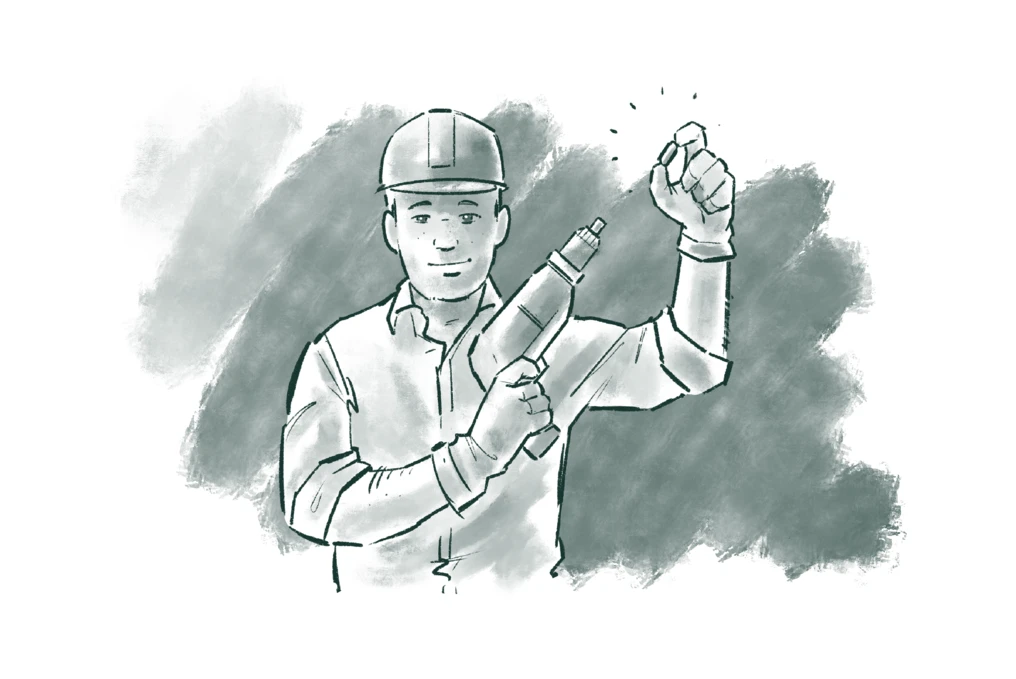We all strive to eat our veggies, fruits, and proteins hoping to keep our bodies as happy and healthy as possible. But have you ever stopped mid-bite to wonder: how exactly does our body turn that delicious avocado into a burst of energy or that juicy orange into a superhero vitamin?
Enzymes: Catalysts of change, masters of transformation ( Enzyme article 1:2 )

Sure, we've got the digestion system—a sort of internal food highway where everything we eat takes a scenic route. But what about the behind-the-scenes magic? How does that slice of bread get transformed into the powerhouse of energy that we need to conquer the day?
This is possible because of the remarkable natural power tools known as enzymes - small biological machines that increase the speed of various processes in living organisms. If enzymes did not exist, all chemical reactions would take place so slowly that the body would not function.
These little guys are like the indispensable public servants of planet Earth. They are everywhere, even deep within our own bodies, making sure that life on Earth continues to thrive. From lending a hand in digestion and healing wounds, to keeping our clothes clean and helping farmers deal with the chaos of climate change, enzymes are the mighty titans we should be thankful for every day.
Grab your magnifying glass and get ready for a journey through the world of enzymes, gifts of biology bestowed upon humanity! Over the next few minutes, we'll unravel the mystery of enzymes—what they are, why they're as essential as that morning cup of coffee, how they work their magic, what enzyme-based biosolutions are all about, and why they might just be the hope we've been waiting for.
Unraveling the mystery of enzymes
In the bustling world of biology, all living things – people, animal and plants – are home to advanced enzyme factories. Made by cells, enzymes are biological molecules, typically proteins. Unlike for instance bacteria, they are not living organisms – but they function as catalysts in living organisms.
What is a catalyst? Well, you can compare it to a game-changer or a ‘provocateur’, if you will - something that ignites a spark and then steps back, letting the reaction unfold without actively participating in it. A power tool that provides the necessary energy to kick-start the process. Or look at them as aids who provide the initial push needed to overcome an energy barrier, allowing the subsequent reaction to proceed more rapidly and efficiently. Like Sisyphus they do the same job again and again.
It's fair to compare enzymes with tiny biological machines with a specific job to do. A bit like a key fits perfectly into one particular lock, each enzyme is uniquely shaped to interact with specific molecules (bodily building blocks), guiding them through vital biochemical transformations with precision and finesse.
It's this remarkable specificity that allows enzymes to accelerate chemical reactions in our bodies and in the world around us at extreme speed. Like invisible little helpers, enzymes roll up their sleeves and get to work, breaking down complex molecules into simpler ones, and rearranging them to create something entirely new. Just a tiny amount of enzyme can catalyze millions of reactions, making them the ultimate multitaskers in the biological world.
And they carry out their magic of turning one thing into another without changing themselves one tiny bit.

How do enzymes work?
Imagine you're tasked with assembling a bookshelf. You have all the parts laid out: screws, bolts, wooden panels, and hinges.
What would you do next? Attempt to assemble them by hand, hoping for the best?
Of course not. It’s not feasible. Unless you want a wobbly bookshelf that might collapse on someone's head any day!
You would use a power drill with various attachments to efficiently piece together the furniture. The power drill, in this scenario, is akin to an enzyme – it ensures the assembly process is faster, transforms the wooden panels and hinges into a new product (the bookshelf), and does not become a part of the final product.
This article is part of The biosolutions bulletin. Want it in your inbox every month?
Let’s break down the steps of how an enzyme works:
Adding enzyme onto a substance:
Just as you first take out your power drill and plug it into the power socket to assemble the bookshelf, you add an enzyme to the substance you want to transform. That’s step one.
The ‘active site’ of the enzyme latches on to the chemicals:
When you add an enzyme to a substance, the enzyme firmly latches on to that substance. They can do this with the help of their ‘active site’. All enzymes have active sites for this purpose – like the specialized drill bits of the power drill, designed to perfectly latch onto the screws and bolts and facilitate their assembly.
Formation of the enzyme-substrate complex:
The combination of enzyme and substrate is called the ‘enzyme-substrate complex’. Imagine the moment when you take the power drill, place it on a screw of the under-construction bookshelf. This connection between the drill and the screw is akin to the enzyme-substrate complex. The enzyme-substrate complex is a temporary association, much like how the drill bit fits into the screw.
Catalysis (acceleration of a chemical reaction):
Once the enzyme-substrate complex is formed, the enzyme forces the substrates to react quickly and efficiently, to produce a new product. This process is catalysis. The substrate on which the enzyme is acting, would just lie there doing nothing if it weren’t for the enzyme – like the various parts of a bookshelf just lying on the floor before they are assembled by the power drill.
In the same way a power drill in quick succession drills one screw after another to form a new product – the bookshelf – the enzyme catalyzes the substrate to transform it into a new product.
Finished product and enzyme ready for use again:
Once the bookshelf is assembled, you set aside the power drill for future use. The drill is ready for use again, just like the enzyme. Once the enzyme has facilitated the transformation of the chemicals into a new product, it detaches itself from the enzyme-substrate complex, leaving behind a new product. The enzyme is then available to be used again in another reaction.
And voila! There you have it. These five steps are how enzymes work their magic, speeding up tasks, forcing chemicals that don’t react with each other to work together and transforming them into a new product. In the end, making life easier for us.
Fact:
Taking fast as lightning to the next level
There’s fast – and there’s catalysis fast! Check out the speed at which enzymes transform a substrate into a new product:
- We all know that human beings inherit features like skin color, looks, height, etc. from their parents. This happens because of a biochemical process called DNA replication.
- For DNA replication to successfully take place, it is essential that a specific chemical is transformed into another chemical called dTMP. This is done by the body with the help of a specific enzyme at a lightning-fast speed of about 18 milliseconds.
- Without the superpower of this particular enzyme, the same bodily reaction would require a mind-boggling 78 million years!
So, what did we learn?
- Enzymes are natural, biological substances.
- They latch onto substrates and force them to react quickly; catalyzing them.
- This catalysis transforms the substrates into completely new products.
If you’re up for some real examples to understand enzymes better, have a look at the “Enzymes at work” article! See you there!

ⓘ This article is a part of The biosolutions bulletin, Issue #2. Discover the rest of the articles from this issue below:
Enzymes at work: Let’s learn through some examples
Discover how enzymes are driving sustainable transformation and innovation.
Digesting the problem: Enzymes chew through plastic pollution
Explore the potential solution of converting emissions from fossil fuels back into fuel.
What is a biosolution?
Microbes and enzymes are tiny but mighty agents of change. For billions of years, they’ve enabled transformation in all living things through microbiology.

What are biosolutions? Where do they come from?
How do they work? What would the world look like without them?
Get the answers to these questions and more from the monthly biosolutions bulletin. Whether you’re an expert who wants to keep on top of the latest innovations or just starting to learn about biosolutions, we’ve got you covered.
With stories ranging from the role of biosolutions in food security to how they enable NOMA-style dining experiences, there’s something for everyone.
Don’t miss out on the latest news about how biosolutions better our world. Sign up to get the biosolutions bulletin delivered directly to your inbox.
One more step…
To complete the get in touch form or sign up, please click on the button below to enable cookies.